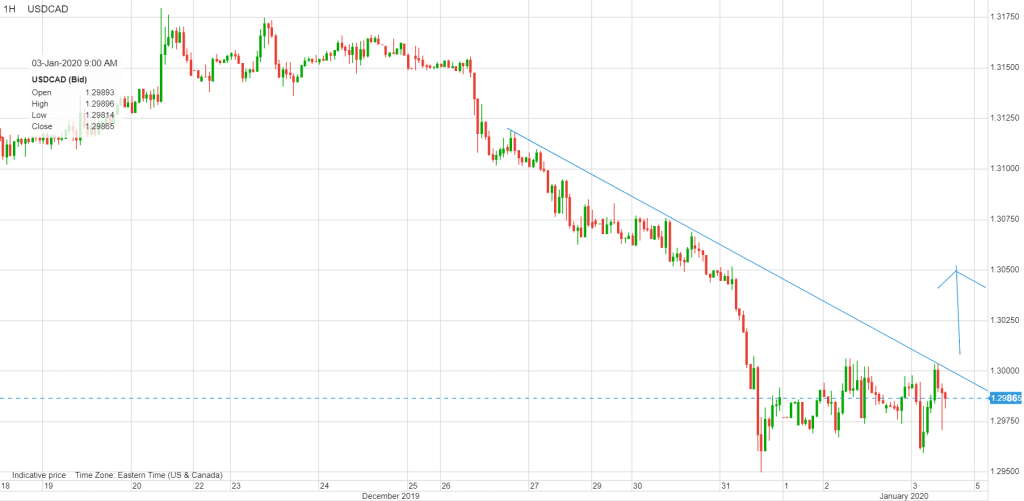
January 3, 2020
USDCAD open 1.2982-85 (6:00 am EST) Overnight Range 1.2963-1.3003
Twenty-nine and a half years ago, the North American FX market awoke to news of “shock and awe” when US-led coalition forces bombed Iraq. Today they awoke to “shock” but not so much “awe.” President Trump ordered an airstrike in Iraq, which killed Iran’s Commander of the Islamic Revolutionary Guard. The Department of National Defense said it was deliberate. Their press release said, “At the direction of the President, the US military has taken decisive defensive action to protect US personnel abroad by killing Qasem Soleimani, the head of the Islamic Revolutionary Guard Corps-Quds Force, a U.S.-designated Foreign Terrorist Organization.”
Markets reacted predictably. Gold, oil, and bond prices soared, Asia and European equity indices fell, and New York equity futures suggest a weak open on Wall Street. Safe-haven currencies were in demand, with traders concerned about Iran’s reaction to the American actions. Thin markets may have exaggerated price movements.
Traders are looking ahead to this mon US ISM Manufacturing PMI data and this afternoon’s release of the FOMC minutes. The US opened with gains against the major G-10 currencies except against the Japanese yen, which rose 0.47% and the Canadian dollar, which was unchanged.
FX Market Snapshot
Change in currency value against the US dollar from NY close to NY open (6:00 am EST)

Source: Saxo Bank/IFXA
EURUSD finished yesterday’s New York session under pressure, and it continued overnight. Broad US dollar demand following the US airstrike, combined with EURJPY selling drove prices below support in the 1.1150-60 area which opened the door to further losses to 1.1110. German CPI was a tad better than expected but traders ignored the results.
GBPUSD crashed below the steep uptrend channel bottom that had been in place since Christmas Eve. US dollar strength, profit-taking and mixed to weak UK economic data fueled the losses. Prices rebounded slightly in New York trading. December Housing Prices rose 0.1%, down from 0.5% in November while the December Construction PMI index, at 44.4 was worse than the forecast of 45.9. Nevertheless, the September uptrend remains intact while prices are above 1.2820, a level guarded by support at 1.2980.
USDJPY plunged to 107.92 from 108.62 in Asia, on the back of safe-haven demand for yen and EURJPY selling. A steep drop in US 10-year Treasury yields, from 1.91% to 1.818% exacerbated the move. The intraday technicals are bearish while prices are below 108.50, looking for a decisive break of support at 108.00 to extend losses to 107.20.
AUDUSD and NZDUSD are quickly giving back all their gains following the news of the US/China Phase 1 trade deal. The Baghdad bombing sparked AUDJPY selling. AUDUSD dropped through support at 0.6960, and the intraday technicals suggest a break of 0.6930 will extend losses to 0.6882.
West Texas Intermediate (WTI) oil prices spiked to $63.71 from $61.17/barrel immediately following news of the US strike in Iraq. Traders fear that Iraq will disrupt crude shipments through the Strait of Hormuz, which would aggravate supply concerns stemming from the latest Opec and Russia production cuts. WTI is trading in New York at its overnight peak.
Gold Prices jumped on safe-haven demand, rising from $1,528.28 to $1,550.29 overnight and reaching a four-month peak. The geopolitical developments accelerated the uptrend in prices that was occurring since December 22.
USDCAD traded steadily but gains were capped by resistance in the 1.3000-05 area. Broad US dollar demand and fears of a hawkish bias to the FOMC are supporting the currency pair. However, the Bank of Canada’s neutral monetary policy and the steep jump in oil prices are also weighing on prices. For today, USDCAD support is at 1.2970 and 1.2950. Resistance is at 1.3005 and 1.3030. Today’s Range 1.2950-1.3005
Chart: USDCAD 1 hour

Source: Saxo Bank





